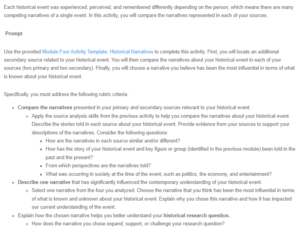Analyzing Historical Narratives
Primary Sources
- Manchikanti, L., Li, S. H., Benyamin, R. M., & Hirsch, J. A. (2017). Evolution of US Health Care Reform. Pain Physician, 20(3), 107-110. Retrieved from https://pubmed.ncbi.nlm.nih.gov/28339426/
- Deng, K. G. (2011). China and the birth of globalization in the 16th century – By Dennis O. Flynn and Arturo Giraldez. Economic History Review, 64(2), 669-713. doi:https://doi.org/10.1111/j.1468-0289.2010.00578_26.x
Secondary sources
- Conklin, T. P. (2002). Health Care in the United States: An Evolving System. Michigan Family Review, 7(1), 5-17. doi:http://dx.doi.org/10.3998/mfr.4919087.0007.102
- Gordon, P., & Morales, J. J. (2017, January). How China played a part in the birth of globalization in the 16th century. Post magazine. Retrieved from https://www.scmp.com/magazines/post-magazine/long-reads/article/2061588/how-china-played-part-birth-globalisation-16th
Compare the narratives presented in your primary and secondary sources relevant to your historical event.
The sources that discuss the evolution of American healthcare provide varying presentations. Manchikanti, L., Benyamin, R. M., & Hirsch, J. A, (2019), provide a narration that touches on different administration aspects that influenced the country’s healthcare. It discusses the steps of various leaders such as Theodore Roosevelt, Franklin D. Roosevelt, President Bill Clinton, Lyndon B. Johnson, Jimmy Carter, President Harry S. Truman, President Barrack Obama, and Hillary Clinton. Therefore, the document explores the policy formulation process that shaped the healthcare system. On the other hand, Conklin (2002), uses a different approach. The author explores the economic factors that are responsible for the various changes in the system. It also highlights the impact on consumers and the actions that should be taken for successful navigation of the system as well as improvement.
The sources that provide information on globalization also differ significantly. Deng (2011), the primary source, is composed of eleven articles that make up a book review. These articles provide different or similar information on the globalization process and China’s role in the same. Gordon & Morales, 2017, the secondary source, is a publication in a magazine. The article is a single author’s narration, which provides their perspective on the role that China played in the globalization process while supporting the information with valid sources.
Describe one narrative that has significantly influenced the contemporary understanding of your historical event.
The American healthcare system is not the best in the world due to inaccessibility. It could learn from other countries’ models, such as Canada and England (Conklin, 2002). This conclusion highlights the changes that the healthcare system still needs to encounter. Not to say that the previous changes have been ineffective, but they have not yet increased access to care sufficiently. This narrative draws my attention to the most recent reforms under Obamacare, which is used as a political tool by presidential candidates. One is able to evaluate its shortcomings and the reasons for a desire to replace it with another reform that is expected to perform better.
Explain how the chosen narrative helps you better understand your historical research question.
This narrative creates an understanding of the need to constantly evaluate the healthcare system. This constant monitoring enables the respective agencies and administrators to improve the existing shortcomings. It also allows benchmarking with other models that achieve the desired goals. This approach introduces the sharing of information among countries and learning among administrators. However, I understand that for these reforms to work, incremental improvements are important. At the same time, the lack of a law that prohibits an incoming president from changing reforms or replacing current ones with new ones could hamper efforts to achieve increased access to care.
ORDER A PLAGIARISM-FREE PAPER HERE
We’ll write everything from scratch
Question

Analyzing Historical Narratives
Each historical event was experienced, perceived, and remembered differently depending on the person, which means there are many competing narratives of a single event. In this activity, you will compare the narratives represented in each of your sources.
Prompt
Use the provided Module Four Activity Template: Historical Narratives to complete this activity. First, you will locate an additional secondary source related to your historical event. You will then compare the narratives about your historical event in each of your sources (two primary and two secondary). Finally, you will choose a narrative you believe has been the most influential in terms of what is known about your historical event.
Specifically, you must address the following rubric criteria:
- Compare the narratives presented in your primary and secondary sources relevant to your historical event.
- Apply the source analysis skills from the previous activity to help you compare the narratives about your historical event. Describe the stories told in each source about your historical event. Provide evidence from your sources to support your descriptions of the narratives. Consider the following questions:
- How are the narratives in each source similar and/or different?
- How has the story of your historical event and key figure or group (identified in the previous module) been told in the past and the present?
- From which perspectives are the narratives told?
- What was occurring in society at the time of the event, such as politics, the economy, and entertainment?
- Apply the source analysis skills from the previous activity to help you compare the narratives about your historical event. Describe the stories told in each source about your historical event. Provide evidence from your sources to support your descriptions of the narratives. Consider the following questions:
- Describe one narrative that has significantly influenced the contemporary understanding of your historical event.
- Select one narrative from the four you analyzed. Choose the narrative that you think has been the most influential in terms of what is known and unknown about your historical event. Explain why you chose this narrative and how it has impacted our current understanding of the event.
- Explain how the chosen narrative helps you better understand your historical research question.
- How does the narrative you chose expand, support, or challenge your research question?

